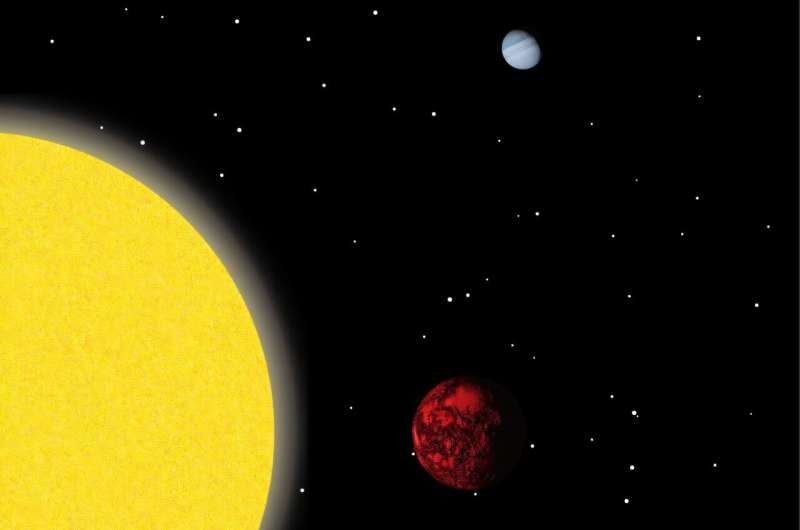
An international team led by researchers in Japan and Europe has discovered a new multi-planet system around a sun-like star, including an ultra-short period planet with one of the highest densities ever measured. The findings, published in Scientific Reports on 8 November, shed new light on the formation and evolution of planets in extreme environments.
The newly discovered system, named K2-360, is located approximately 750 light-years from Earth. It consists of two planets orbiting a star similar to our sun:
- K2-360 b: An ultra-short period “super-Earth” (rocky planet larger than Earth but smaller than Neptune) about 1.6 times the size of Earth, orbiting its star every 21 hours. With a mass 7.7 times that of Earth, it is the densest well-characterized planet of its kind discovered to date.
- K2-360 c: A larger outer planet at least 15 times more massive than Earth, orbiting every 9.8 days. This planet does not transit its star, so its exact size is unknown.
“K2-360 b is truly remarkable—it’s as dense as lead, packing nearly 8 Earth masses into a ball only slightly larger than our planet,” says John Livingston, lead author of the study from the Astrobiology Center in Tokyo, Japan. “This makes it the densest known planet among the class of ‘ultra-short period’ planets [with precise parameters], which orbit their stars in less than a day.”
The discovery was made possible by NASA’s K2 mission, which first detected the inner planet transiting in front of its star in 2016. Follow-up observations with ground-based telescopes, including the HARPS and HARPS-N spectrographs, confirmed the planet’s nature and revealed the presence of the outer companion.
The extreme density of K2-360 b suggests it may be the stripped core of a once-larger planet, having lost its outer layers due to intense radiation from its nearby host star.
“This planet gives us a glimpse into the possible fate of some close-in worlds, where only the dense, rocky cores remain after billions of years of evolution,” explains co-author Davide Gandolfi from the University of Turin.
The outer planet, K2-360 c, adds another layer of intrigue to the system. While not transiting its star, its gravitational pull on the host star allowed researchers to measure its minimum mass. Computer simulations suggest it may have played a crucial role in the formation and evolution of the system.
While many close-in planets are thought to have migrated inward through interactions with their natal gas disk, K2-360 b likely followed a different path.
“Our dynamical models indicate that K2-360 c could have pushed the inner planet into its current tight orbit through a process called high-eccentricity migration,” says co-author Alessandro Trani from the Niels Bohr Institute.
“This involves gravitational interactions that first make the inner planet’s orbit very elliptical, before tidal forces gradually circularize it close to the star. Alternatively, tidal circularization could have been induced by the spin-axial tilt of the planet.”
Discover the latest in science, tech, and space with over 100,000 subscribers who rely on Phys.org for daily insights.
Sign up for our free newsletter and get updates on breakthroughs,
innovations, and research that matter—daily or weekly.
The team’s analysis suggests that K2-360 b has an iron-rich, rocky composition more similar to Earth than Mercury. Using models based on the observed chemical abundances of the host star, the researchers estimate that K2-360 b likely has a large iron core making up about 48% of its mass. This places it closer to being a “super-Earth” than a “super-Mercury,” despite its extreme density.
“Our interior structure models indicate that K2-360 b probably has a substantial iron core surrounded by a rocky mantle,” explains co-author Mahesh Herath, a Ph.D. candidate at McGill University. “Its surface may be covered in magma due to the intense heat it receives from its star. Understanding planets like this helps us piece together how terrestrial planets form and evolve under different conditions throughout the galaxy.”
The discovery of the K2-360 system provides valuable insights into planetary system architectures and the processes that shape them. Ultra-short period planets like K2-360 b are relatively rare, and finding one with a massive outer companion helps constrain theories about their formation.
“K2-360 is an excellent laboratory for studying how planets form and evolve in extreme environments,” concludes Livingston.
More information:
John H. Livingston et al, An ultra-short-period super-Earth with an extremely high density and an outer companion, Scientific Reports (2024). DOI: 10.1038/s41598-024-76490-y
Journal information:
Scientific Reports
Provided by
National Institutes of Natural Sciences
Astronomers discover ultra-dense ‘super-Earth’ with outer companion offering clues about its formation (2024, November 15)
retrieved 15 November 2024
from https://phys.org/news/2024-11-astronomers-ultra-dense-super-earth.html
part may be reproduced without the written permission. The content is provided for information purposes only.